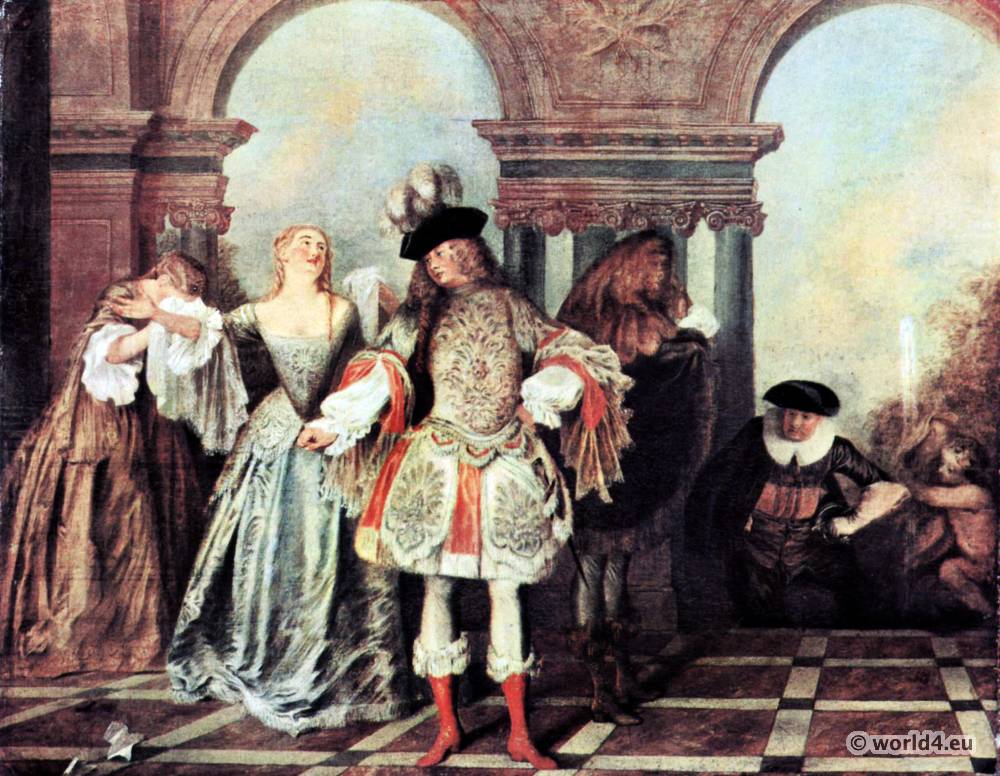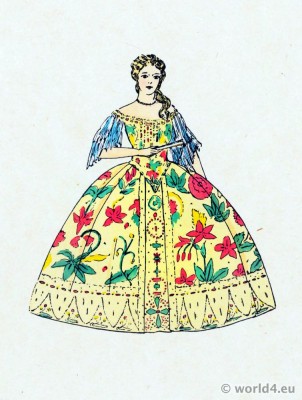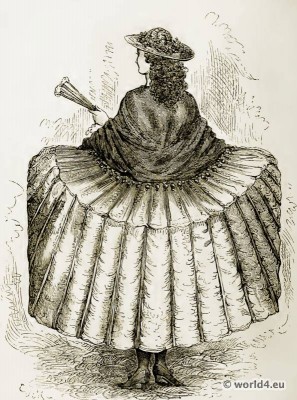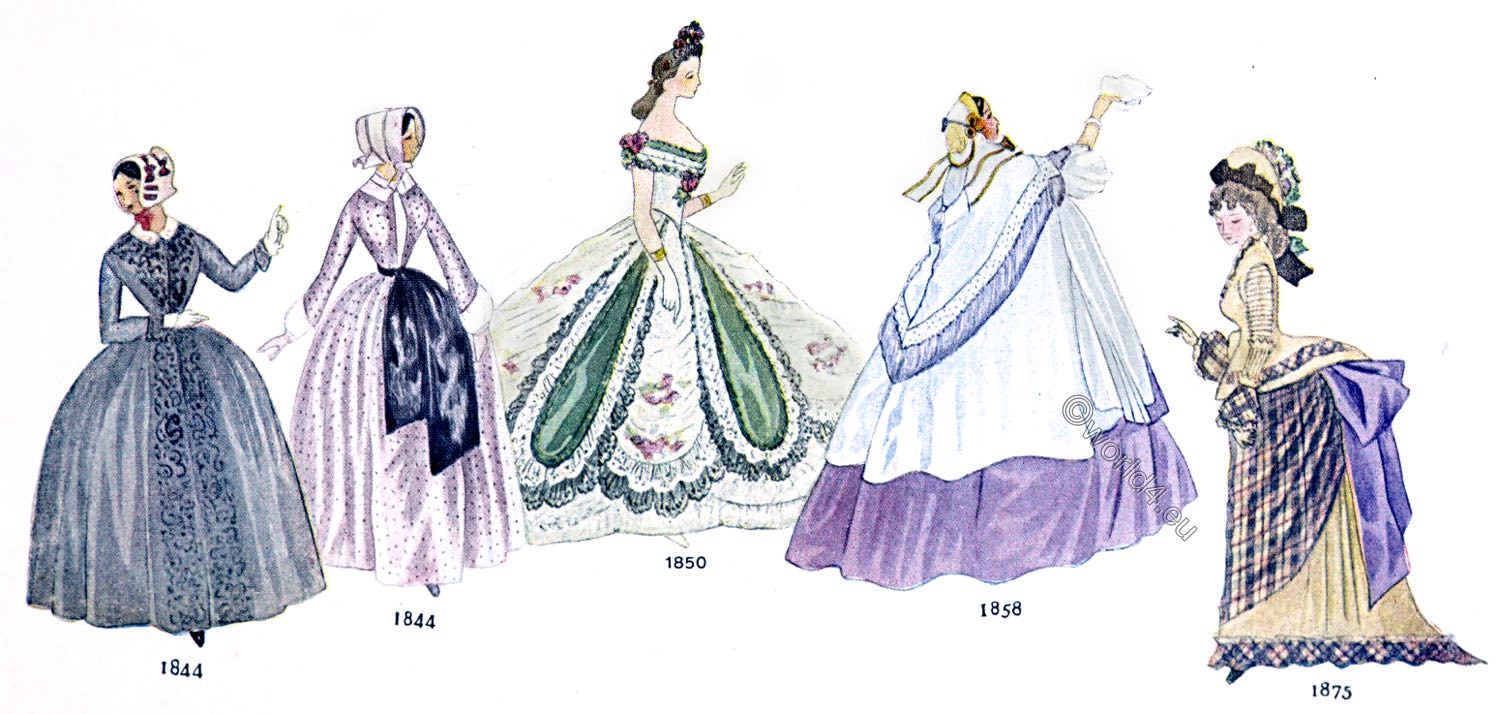Corsets and Crinolines 1st Edition by Norah Waugh & Judith Dolan.
In this classic book, Norah Waugh explores the changing shapes of women’s dress from the 1500s to the 1920s. Simple laced bodices became corsets of cane, whalebone and steel, while padding at shoulders and hips gave way to the structures of farthingales, hoops and bustles.
Stays and Corsets: Historical Patterns Translated for the Modern Body by Mandy Barrington.
Using her original pattern-drafting system, author Mandy Barrington will show you how to draft a historical pattern for a modern body shape, while still retaining an accurate historical silhouette.
CHAPTER VI
Fashion during the reign of Louis XV. – Costumes à la Watteau – An army of barbers – The fashions of England during the reign of Queen Anne – The diminutive waist and enormous hoop of her day – The farthingale: letters in the Guardian protesting against its use – Fashion in 1713 – Low dresses, tight stays, and short skirts: letters relating to – Correspondence touching the fashions of that period from the Guardian – Accomplishments of a lady’s-maid – Writings of Gay and Ben Jonson – Their remarks on the “bodice” and ‘”stays.”
Fashion during the reign of Louis XV. Costumes à la Watteau.
At the death of Louis XIV. and the accession of his successor, Louis XV., in 1715, fashions ran into wonderful extremes and caprices. Hoops became the rage, as did patches, paint, and marvellously high-heeled shoes. The artistic skill of Watteau in depicting costume and devising the attributes of the favourite fancy dresses of the time, led to their adoption among the votaries of fashion. Shepherds who owned no sheep were tricked out in satins, laces, and ribbons, and tripped it daintily hand in hand with the exquisitely-dressed, slender-waisted shepherdesses we see reproduced in Dresden china and the accompanying illustration.
Guitars tinkled beneath the trees of many a grove in the pleasure-grounds of the fine old chateaux of France; fruit strewed on the ground, costly wines in massive flagons, groups of gay gallants and charming belles, such as the accompanying illustration represents, engaged in love-making music and flirtation, make up the scene on which Watteau loved most to dwell and which Kin Louis gay subjects were not slow in performing to the life, and the happy age of the poet appeared all but realised:
“There was once a golden time
When the world was in its prime-
When every day was holiday,
And every shepherd learned to love.”
The fashions of England during the reign of Queen Anne.
To carry out the everyday life of this dream world, no small amount of sacrifice and labour was needed, and we are informed that over twelve hundred hairdressers were in full occupation in Paris alone, frizzing, curling, and arranging in a thousand and one fantastical ways, hours being needed to perfect the head-gear of a lady of ton.
For the prevailing fashions of England we must step back a few years, and glance at the latter portion of the reign of Queen Anne, at which time we find the diminutive size of the waist in marked contrast to the enormous dimensions of the hoop or farthingale, which reached such a formidable size that numerous remonstrances appeared in the journals of the day relative to it. The following letter complaining of the grievance appeared in the Guardian of July 22, 1713:
“MR. GUARDIAN,- Your predecessor, the Spectator, endeavoured, built in vain, to improve the charms of the fair sex by exposing their dress whenever it launched into extremities. Amongst the rest the great petticoat came under his consideration, built in contradiction to whatever he has said, they still resolutely persist in this fashion.
The form of their bottom is not, I confess, altogether the same, for whereas before it was one of an orbicular make, they now look as if they were pressed so that they seem to deny access to any part but the middle. Many are the inconveniences that accrue to her majesty’s loving subjects from the said petticoats, as hurting men’s shins, sweeping down the ware of industrious females in the street, &c. I saw a young lady fall down the other day, and, believe me, Sir, she very much resembled an overturned bell without a clapper.
Many other disasters I could tell you of that befall themselves as well as others by means of this unwieldy garment. I wish, Mr. Guardian, you would join with me in showing your dislike of such a monstrous fashion, and I hope, when the ladies see this, the opinion of two of the wisest men in England, they will be convinced of their folly.
I am, Sir, your daily reader and admirer, TOM PAIN.”
The accompanying illustration will show that these remonstrances were not without cause.
Correspondence touching the fashions of that period from the Guardian
The fashion of wearing extremely low dresses, with particularly short skirts, also led to much correspondence and many strong remarks, which are duly commented on by the editor of the Guardian, assisted by his’ “good old lady,” as he calls her, “the Lady Lizard.” Thus he writes on the subject under discussion:
Editorial letter. GUARDIAN July 16, 1713.
“I am very well pleased with this approbation of my good sisters. I must confess I have always looked on the ‘tucker’ to be the decus et tutamen (Inscription on British one-pound coins. Originally on 17th-century coins, it refers to the inscribed edge as a protection against the clipping of precious metal. The phrase originally comes from Virgil’s Aeneid.), the ornament and defence of the female neck. My good old lady, the Lady Lizard, condemned this fashion from the beginning, and has observed to me, with some concern, that her sex at the same time they are letting down their stays are tucking up their petticoats, which grow shorter and shorter every day.
The leg discovers itself in proportion with the neck, but I may possibly take another occasion of handling this extremity, it being my design to keep a watchful eye over every part of the female sex, and to regulate them from head to foot. In the meantime I shall fill up my paper with a letter which comes to me from another of my obliged correspondents.”
That these very low dresses were not alone worn in the house and at assemblies, but were also occasionally seen on the promenades, is shown by the following satirical appeal to the editor of the journal from which we have just been quoting, and the accompanying illustration represents the too-fascinating style of costume which caused its writer so much concern:
Wednesday, August 12, 1713.
“Notwithstanding your grave advice to the fair sex not to lay the beauties of their necks so open, I find they mind you so little that we (116) young men are as much in danger as ever. Yesterday, about seven in the evening, I took a walk with a gentleman, just come to town, in a public walk.
We had not walked above two rounds when the spark on a sudden pretended weariness, and as I importuned him to stay longer he turned short, and, pointing out a celebrated beauty, ‘What,’ said he, ‘do you think I am made of, that I could bear the sight of such snowy beauties? She is intolerably handsome.’ Upon this we parted, and I resolved to take a little more air in the garden, yet avoid the danger, by casting my eyes downwards; but, to my unspeakable surprise, discovered in the same fair creature the finest ankle and prettiest foot that ever fancy imagined. If the petticoats as well as the stays thus diminish, what shall we do, dear Mentor? It is neither safe to look at the head nor the feet of the charmer. Whither shall we direct our eyes? I need not trouble you with my description of her, but I beg you would consider that your wards are frail and mortal.
Your most obedient servant, EPERNECTISES.”
There is no source, perhaps, from which a clearer view of the fashions of this period, and mode of thought then entertained concerning them, could be obtained than the antiquated journal we have just quoted from. The opinions therein expressed, and the system of reasoning adopted by some of the contributors to its columns, are so singularly quaint that we cannot resist giving the reader the benefit of them.
The happy vein of philosophy possessed by the writer of the following letter must have made the world a mere pleasure-garden, through which he wandered at his own sweet will, “king of the universe:”
GUARDIAN, Friday, May 8th, 1713.
“When I walk the streets I use the foregoing natural maxim (viz., that he is the true possessor of a thing who enjoys it, and not he that owns it without the enjoyment of it) to convince myself that I have a property in the gay part of all the gilt chariots that I meet, which I regard as amusements designed to delight the eye and the imagination of those kind people who sit in them gaily attired only to please me. I have a real and they only an imaginary pleasure from their exterior embellishments.
Upon the same principle I have discovered that I am the natural proprietor of all the diamond necklaces the crosses and stars, brocades and embroidered cloths which I see at a play or birthnight, as giving more natural delight to the spectator than to those who wear them; and I look on the beaux and ladies as so many paroquets in an aviary or tulips in a garden, designed purely for my diversion. A, gallery of pictures, a cabinet, or library that I have free access to, I think my own. In a word, all that I desire is the use of things, let who will have the keeping of them. By which maxim I am rowing one of the richest men 1n Great Britain, with this difference, that I am not a prey to my own cares or the envy of others.”
The reply to the foregoing letter by a lady of fashion, written with a strong dash of satire, is equally curious in its way, as it shows the great importance attached to a pleasing and attractive exterior:
To the Editor of the GUARDIAN. Tuesday, May 19th, 1713.
“Sir, I am a lady of birth and fortune, but never knew till last Thursday that the splendour of my equipage was so beneficial to my country. I will not deny that I have dressed for some years out of the pride of my heart, but am very glad that you have so far settled my conscience in that particular that now I can look upon my vanities as so many virtues, since I am satisfied that my person and garb give pleasure to my fellow creatures. I shall not think the three hours’ business I usually devote to my toilette below the dignity of a rational soul. I am content to suffer great torment from my stays that my shape may appear graceful to the eyes of others, and often mortify myself with fasting rather than my fatness should give distaste to any man in England. I am making up a rich brocade for the benefit of mankind, and design in a little time to treat the town with a thousand pounds’ worth of jewellery. I have ordered my chariot to be newly painted for your use and the world’s, and have prevailed upon my husband to present you with a pair of Flanders mares, by driving them every evening round the ring. Gay pendants for my ears, a costly cross for my neck, a diamond of the best water for my finger shall be purchased, at any rate, to enrich you, and I am resolved to be a patriot in every limb. My husband will not scruple to oblige me in these trifles, since I have persuaded him, from your scheme, that pin-money is only so much money set for charitable uses. You see, Sir, how expensive you are to me, and I hope you will esteem me accordingly, especially when I assure you that I am, as far as you can see me,
Entirely yours, CLEORA.”
The tight lacing and tremendously stiff corsets of the time were also the subjects of satirical remark in some quarters, and were upheld in others, as the two following letters, copied from the Guardian of 1713, will show:
Thursday, June 18th, 1713.
“Sir, I don’t know at what nice point you fix the bloom of a young lady, but I am one who can just look back on fifteen. My father dying three years ago left me under the care and direction of my mother, with a fortune not profusely great, yet such as might demand a very handsome settlement if ever proposals of marriage should be offered. My mother, after the usual time of retired mourning was over, was so affectionately indulgent to me as to take me along with her in all her visits, but still, not thinking she gratified my youth enough, permitted me further to go with my relatives to all the publick cheerful but innocent entertainments, where she was too reserved to appear herself.
The two first years of my teens were easy, gay, and delightful; every one caressed me, the old ladies told me how finely I grew, and the young ones were proud of my company; but when the third year had a little advanced, my relations used to tell my mother that pretty Miss Clarey was shot up into a woman.
The gentlemen began now not to let their eyes glance over me, and in most places I found myself distinguished, but observed the more I grew into the esteem of their sex, the more I lost the favour of my own; some of those whom I had been familiar with grew cold and indifferent; others mistook by design my meaning, made me speak what I never thought, and so, by degrees, took occasion to break off acquaintance. There were several little insignificant reflections cast upon me, as being a lady of a great many acquaintances, and such like, which I seemed not to take notice of. But my mother coming home about a week ago, told me there was a scandal spread about town by my enemies that would at once ruin me for ever for a beauty. I earnestly intreated her to know it; she refused me, but yesterday it discovered itself.
Being in an assembly of gentlemen and ladies, one of the gentlemen, who had been very facetious to several of the ladies, at last turned to me. ‘And as for you, madam, Prior has already given us your character:
‘That air and harmony of shape express,
Fine by degrees and beautifully less.’
I perceived immediately a malignant smile display itself in the countenance of some of the ladies, which they seconded with a scornful flutter of the fan, till one of them, unable any longer to contain herself, asked the gentleman if he did not remember what Congreve said about Aurelia, for she thought it mighty pretty. He made no answer, but instantly repeated the verses –
‘The Mulcibers who in the Minories sweat,
And massive bars on stubborn anvils beat,
Deformed themselves, yet forge those stays of steel,
Which arm Aurelia with a shape to kill.’
This was no sooner over but it was easily discernable what an ill-natured satisfaction most of the company took, and the more pleasure they showed by dwelling upon the two last lines, the more they increased my trouble and confusion.
And now, Sir, after this tedious account, what would you advise me to? Is there no way to be cleared of these malicious calumnies? What is beauty worth that makes the possessed thus unhappy? Why was Nature so lavish of her gifts to me as to make her kindness prove a cruelty? They tell me my shape is delicate, my eyes sparkling, my lips I know not what, my cheeks, forsooth, adorned with a just mixture of the rose and lillie; but I wish this face was barely not disagreeable, this voice harsh and unharmonious, these limbs only not deformed, and then perhaps I might live easie and unmolested, and neither raise love and admiration in the men, nor scandal and hatred in the women.
Your very humble servant, CLARINA
Editor’s Reply to Letter of Thursday, June 18th, 1713:
“The best answer I can make my fair correspondent is, that she ought to comfort herself with this consideration, that those who talk thus of her know it is false, but wish to make others believe it is true. ‘Tis not they think you deformed, but are vexed that they themselves were not so nicely framed. If you will take an old man’s advice, laugh and not be concerned at them; they have attained what they endeavoured if they make you uneasie, for it is envy that has made them.
I would not have you with your shape one fiftieth part of an inch disproportioned, nor desire your face might be impoverished with the ruin of half a feature, though numbers of remaining beauties might make the loss insensible; but take courage, go into the brightest assemblies, and the world will quickly confess it to be scandal. Thus Plato, hearing it was asserted by some persons that he was a very bad man ‘I shall take care,’ said he ‘to live so that nobody will believe them.’ “The milliners and lady’s-maids of the time were expected to fully understand all matters relating to the training of the figure.
A writer of this period, in speaking of the requisite accomplishments of a mantua-maker, says: “She must know how to hide all the defects in the proportions of the body, and must be able to mould the shape by the stays so as to preserve the intestines, that while she corrects the body she may not interfere with the pleasures of the palate.”
Some difference of opinion has existed as to the period at which the word “stays” was first used to indicate an article of dress of the nature of the corset or bodice. It is evident that the term must have been perfectly familiar long anterior to 1713, as constant use is made of it in the letters we have just given. Gay, who wrote about 1720, also avails himself of it in The Toilette:
“I own her taper form is made to please,
Yet if you saw her unconfined by stays!”
The word “bodice,“ or “bodice,“ was not unfrequently spelt bodies by old authors, amongst whom may be mentioned Ben Jonson, who wrote about 1600, and mentions
“The whalebone man
That quilts the bodies
I have leave to span.”
Source: The Corset and the Crinoline. A Book of Modes and Costumes from remote Periods to the Present Time by W. B. L. (William Berry Lord). London: Ward, Lock, and Tyler. Warwick House, Paternoster Row. 1868.
Related
Corsets and Crinolines 1st Edition by Norah Waugh & Judith Dolan.
In this classic book, Norah Waugh explores the changing shapes of women’s dress from the 1500s to the 1920s. Simple laced bodices became corsets of cane, whalebone and steel, while padding at shoulders and hips gave way to the structures of farthingales, hoops and bustles.
Stays and Corsets: Historical Patterns Translated for the Modern Body by Mandy Barrington.
Using her original pattern-drafting system, author Mandy Barrington will show you how to draft a historical pattern for a modern body shape, while still retaining an accurate historical silhouette.











